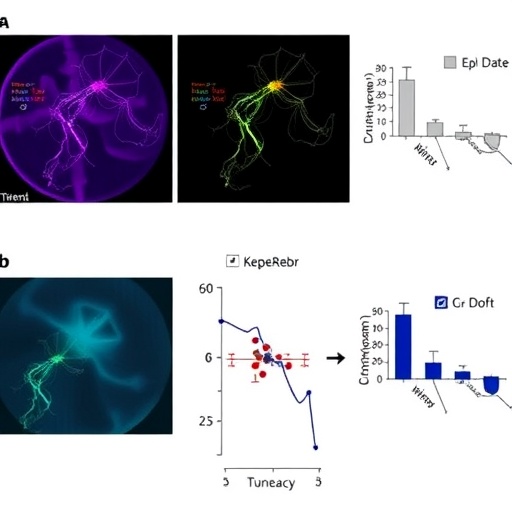A groundbreaking study led by researchers at the University of Southern California (USC) has revealed a compelling connection between type 2 diabetes mellitus (T2DM) and reduced cortical thickness in the brains of older adults across diverse ethnic groups. This research provides critical insight into how chronic metabolic disorders can affect brain morphology, potentially accelerating age-related cognitive decline. Published in the prestigious journal Alzheimer’s & Dementia: Diagnosis, Assessment & Disease Monitoring, this study underscores the urgency of managing blood sugar levels to safeguard brain health, particularly in aging populations.
Type 2 diabetes mellitus is a pervasive chronic condition affecting approximately 10% of the American population. It is characterized by insulin resistance and resultant hyperglycemia, which, over time, exerts profound systemic effects. While diabetes is well-known for its role in cardiovascular and renal pathology, this new study highlights its significant neurological repercussions. The researchers documented that individuals with T2DM exhibited a pronounced reduction in cortical thickness—especially within the temporal and parietal lobes—regions intrinsically linked to memory processing, attention, and executive functioning.
The research team, hailing from the Keck School of Medicine of USC’s Mark and Mary Stevens Neuroimaging and Informatics Institute (Stevens INI), in collaboration with the University of North Texas Health Science Center and the University of Texas at Austin, leveraged sophisticated neuroimaging techniques to quantify cortical thickness and hippocampal volume. Their cohort was drawn from the Health and Aging Brain Study-Health Disparities (HABS-HD), an ethnically diverse study population including Hispanic, non-Hispanic Black, and non-Hispanic white older adults. This diversity allowed investigators to probe the interactions between ethnicity, diabetes, and brain structure with unprecedented resolution.
By employing magnetic resonance imaging (MRI) to capture high-resolution anatomical data, the researchers measured cortical thickness—a biomarker increasingly recognized for its sensitivity to neurodegenerative processes and cognitive aging. Their advanced imaging analyses revealed that diabetic participants showed significant cortical thinning not only in the temporal and parietal regions but also in associated areas known to support cognitive resilience. Importantly, these structural differences were more pronounced in participants with poor glycemic control, emphasizing the detrimental effects of sustained hyperglycemia on the central nervous system.
The study’s key innovation lies in its ethnically inclusive design. Notably, Hispanic participants with T2DM exhibited the strongest associations between diabetes and cortical thinning, whereas non-Hispanic Black adults showed no statistically significant effects. This disparity hints at underlying genetic, environmental, or sociocultural factors modulating the neurological impact of diabetes. It calls for further mechanistic research to unravel how ethnicity interacts with metabolic dysregulation to influence brain health trajectories.
Crucially, the researchers accounted for common comorbidities such as hypertension, obesity, and dyslipidemia, as well as socioeconomic variables. The persistence of the diabetes-cortical thinning link despite controlling for these potential confounds strengthens the argument for a direct pathological influence of diabetes on neural substrates. Such findings illuminate the multifactorial and complex pathways through which metabolic disorders may contribute to neurodegeneration and cognitive impairment.
These revelations bear profound clinical implications. Since type 2 diabetes is both preventable and manageable through lifestyle interventions and pharmacotherapy, maintaining optimal glycemic control emerges as a modifiable target to curtail neurodegenerative risk. The study emphasizes the potential to stave off dementia and related cognitive disorders by prioritizing metabolic health in at-risk older adults.
Lead author Amaryllis A. Tsiknia, a doctoral candidate spearheading this investigation, highlights the translational importance of these findings: “Our work suggests that early detection and rigorous management of diabetes could substantially protect against brain atrophy and its cognitive consequences.” This proactive approach aligns with emerging paradigms advocating integrated care models that merge endocrinology and neurology to more holistically address aging-related diseases.
Senior author Meredith N. Braskie, PhD, assistant professor of neurology and co-lead of the HABS-HD study, elaborates on the disparities revealed: “The ethnic and racial differences in diabetes-related brain changes signify that personalized medicine approaches are essential. Understanding how multiple risk factors converge differently across populations is vital to developing targeted interventions that optimize brain health.” Such perspectives herald a new frontier in precision neuroscience, where sociocultural context informs prevention strategies.
Stevens INI director Arthur W. Toga, PhD, underscored the pivotal role of large-scale, longitudinal initiatives like HABS-HD in facilitating these discoveries. “The comprehensive data collection process—from neuroimaging to cognitive assessments—provides unparalleled insight into the links between systemic diseases and brain aging. Our capacity to integrate diverse datasets is essential for uncovering complex interdependencies and advancing the science of neurodegeneration,” he stated.
The authors anticipate future longitudinal analyses to elucidate whether the observed cortical thinning in diabetics translates into an accelerated trajectory of cognitive decline and dementia onset. Such data could inform risk stratification and early intervention frameworks. Additionally, investigations into the neuroprotective potential of specific diabetes medications and lifestyle modifications are warranted to identify effective strategies for preserving brain integrity in diabetic populations.
The study bridges critical gaps in our understanding of the intersection between metabolic and neurodegenerative diseases, underscoring the brain as a vulnerable target of systemic metabolic dysregulation. With the prevalence of type 2 diabetes rising globally—amplified in minority communities—the findings spotlight an urgent imperative to integrate metabolic and neurological health initiatives within public health paradigms.
Access to the HABS-HD dataset remains available to qualified researchers through collaborative mechanisms, fostering continued scientific advancement. Funding from the National Institutes of Health and the National Institute on Aging supported this transformative work, reflecting the priority status of research at the nexus of diabetes and dementia.
In sum, this pioneering USC-led investigation lays a foundational framework for unraveling how chronic metabolic diseases sculpt brain architecture across diverse populations. Its implications extend beyond academic discourse, propelling clinical practices that prioritize metabolic control for cognitive resilience during aging. The study’s revelations herald a new era wherein managing diabetes transcends peripheral health, embracing neuroprotective stewardship in the quest for healthy brain aging.
Subject of Research: People
Article Title: Diabetes and cortical thickness in ethnically diverse cognitively normal older adults
News Publication Date: 9-May-2025
Web References:
https://ini.usc.edu/
https://alz-journals.onlinelibrary.wiley.com/doi/10.1002/dad2.70088
https://apps.unthsc.edu/itr/habs-hd
https://www.gaaindata.org/partner/HABS
References:
Tsiknia AA, Tennant V, Lee N, Hall BJ, Vintimilla R, Hazra N, Kothapalli D, Toga AW, O’Bryant SE, Nandy R, Clark AL, Petersen M, Yaffe K, Braskie MN. Diabetes and cortical thickness in ethnically diverse cognitively normal older adults. Alzheimer’s & Dementia: Diagnosis, Assessment & Disease Monitoring. 2025; DOI:10.1002/dad2.70088.
Image Credits: USC Stevens INI
Keywords: Type 2 diabetes, Brain structure, Cortical thickness, Cognitive function, Glucose, Neuroimaging, Magnetic resonance imaging, Dementia, Alzheimer disease
Tags: Alzheimer’s disease and diabetes connectionblood sugar levels and brain healthchronic conditions and brain structurecognitive decline in older adultscortical thickness and agingdiverse ethnic groups and diabetesinsulin resistance and cognitive functionmemory processing in aging populationsmetabolic disorders and brain morphologyneurological effects of diabetesType 2 diabetes and brain healthUSC diabetes study





